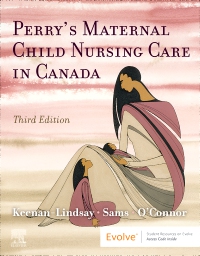
Perry's Maternal Child Nursing Care in Canada Elsevier eBook on VitalSource, 3rd Edition
Elsevier eBook on VitalSource

Now $87.29
Featuring the most accurate, current, and clinically relevant information available, Perry’s Maternal Child Nursing Care in Canada combines essential maternity and pediatric nursing information in one text. Comprehensive coverage includes promotion of wellness and the care for persons experiencing common health concerns throughout the lifespan, care in childbearing, as well as the health care of children and child development in the context of the family. Health concerns, including physiological dysfunctions and special needs and illnesses, are also featured. This text provides a family-centred care approach that recognizes the importance of collaboration with families when providing care.
Newer Edition Available
Perry’s Maternal Child Nursing Care in Canada - Elsevier E-Book on VitalSource
-
- Medication Alerts stress medication safety concerns for better therapeutic management.
- Safety Alerts highlighted and integrated within the content draw attention to developing competencies related to safe nursing practice.
- Research Focus boxes identify best practices by presenting evidence and how to apply the knowledge learned.
- Atraumatic Care boxes in the pediatric unit teach you how to provide competent and effective care to pediatric patients with the least amount of physical or psychological stress.
- Community Focus boxes emphasize community issues, supply resources and guidance, and illustrate nursing care in a variety of settings.
- Clinical reasoning case studies offer you opportunities to test and develop your analytical skills and apply knowledge in various settings.
- Cultural Awareness boxes explore beliefs and practices about pregnancy, childbirth, parenting, women's health concerns, and caring for sick children.
- Evidence-Informed Practice boxes highlight findings that confirm effective practices or that identify practices with unknown, ineffective, or harmful effects.
- Emergency boxes alert you to emergency situations and guide you step-by-step through emergency procedures.
- Family-Centred Care boxes highlight the needs or concerns of families that you should consider in providing family-centred care.
- Guidelines boxes outline nursing procedures in an easy-to-follow format.
- Home Care boxes detail important information that you need to deliver care to patients and families in the home setting.
- Medication Guide boxes include key information about medications used in maternity and newborn care, including their indications, adverse effects, and nursing considerations.
- Patient Teaching boxes assist you in helping patients and families become involved in their own care with optimal outcomes.
-
- NEW! Consolidated, revised, and expanded mental health concerns chapter and consolidated pediatric health promotion chapter offer current and concise coverage of these key topics.
- NEW and UPDATED! Information on the latest guidelines includes SOGC guidelines, STI and CAPWHN perinatal nursing standards, Canadian Pediatrics Association Standards, Canadian Association of Midwives, and more.
- NEW! Coverage reflects the latest Health Canada Food Guide recommendations.
- UPDATED! Expanded coverage focuses on global health perspectives and health care in the LGBTQ2 community, Indigenous, immigrant, and other vulnerable populations.
- EXPANDED! Additional case studies and clinical reasoning/clinical judgement-focused practice questions in the printed text and on the Evolve companion website promote critical thinking and prepare you for exam licensure.
- NEW! Case studies on Evolve for the Next Generation NCLEX-RN® exam provide practice for the Next Generation NCLEX.
-
PART 1: MATERNAL CHILD NURSING
UNIT 1: INTRODUCTION TO MATERNAL CHILD NURSING
1. Contemporary Perinatal and Pediatric Nursing in Canada
2. The Family and Culture
3. Community Care
PART 2: PERINATAL NURSING
UNIT 2: INTRODUCTION TO PERINATAL NURSING
4. Perinatal Nursing in Canada
UNIT 3: WOMEN'S HEALTH
5. Health Promotion
6. Health Assessment
7. Reproductive Health
8. Infertility, Contraception, and Abortion
UNIT 4: PREGNANCY
9. Preconception, Genetics, Conception, and Fetal Development
10. Anatomy and Physiology of Pregnancy
11. Nursing Care During Pregnancy
12. Maternal Nutrition During Pregnancy
13. Pregnancy Risk Factors and Assessment
14. Pregnancy at Risk: Gestational Conditions
15. Pregnancy at Risk: Pre-existing Conditions
UNIT 5: CHILDBIRTH
16. Labour and Birth Processes
17. Nursing Care of the Family During Labour and Birth
18. Pain Management During Labour
19. Fetal Health Surveillance During Labour
20. Labour and Birth at Risk
UNIT 6: POSTPARTUM PERIOD
21. Postpartum Maternal Physiological Changes
22. Nursing Care of the Family During the Postpartum Period
23. Transition to Parenthood
24. Postpartum Complications
UNIT 7: NEWBORN
25. Physiological Adaptations of the Newborn
26. Nursing Care of the Newborn and Family
27. Newborn Nutrition
28. Infants with Gestational Age Related Problems
29. The Newborn at Risk: Acquired and Congenital Problems
PART 3: PEDIATRIC NURSING
UNIT 8: CHILDREN, THEIR FAMILIES, AND THE NURSE
30. Pediatric Nursing in Canada
31. Family, Social, Cultural, and Religious Influences on Children's Health
32. Developmental Influences on Child Health
UNIT 9: ASSESSMENT OF THE CHILD AND FAMILY
33. Communication, History, Physical, and Developmental Assessment
34. Pain Assessment and Management
UNIT 10: DEVELOPMENTAL STAGES AND HEALTH PROMOTION
35. The Infant and Family
36. The Toddler and Family
37. The Preschooler and Family
38. The School-Age Child and Family
39. The Adolescent and Family
40. Pediatric Health Promotion
UNIT 11: SPECIAL NEEDS, ILLNESS, AND HOSPITALIZATION
41. Chronic Illness, Complex Conditions, and End-of-Life Care
42. Cognitive and Sensory Impairment
43. Reaction to Illness and Hospitalization
44. Pediatric Variations of Nursing Interventions
UNIT 12: HEALTH PROBLEMS OF CHILDREN
45. Respiratory Concerns
46. Gastrointestinal Concerns
47. Cardiovascular Dysfunction
48. Hematological and Immunological Dysfunction
49. Genitourinary Dysfunction
50. Cerebral Dysfunction
51. Endocrine Dysfunction
52. Integumentary Dysfunction
53. Musculoskeletal or Articular Dysfunction
54. Neuromuscular or Muscular Dysfunction
55. Mental Health Concerns








 as described in our
as described in our 